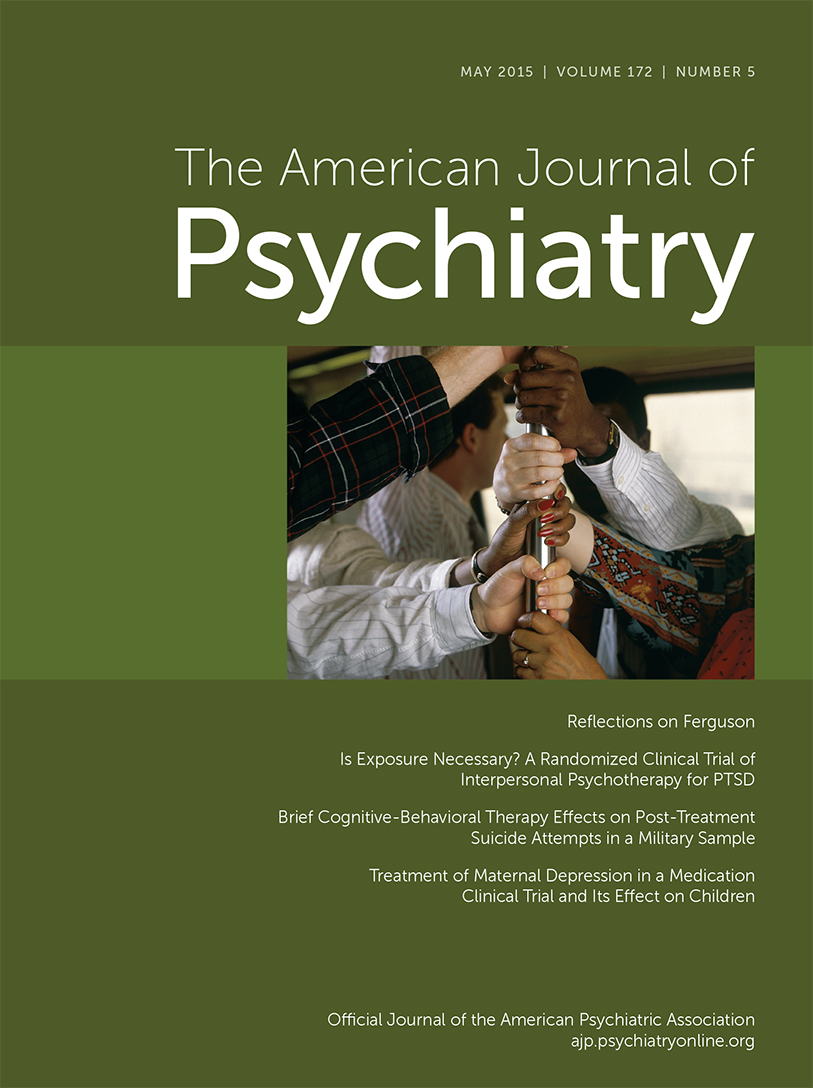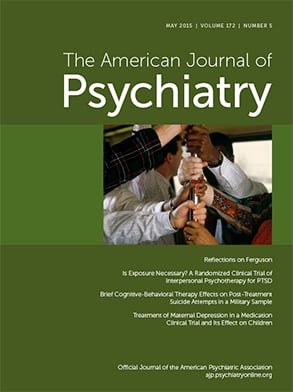Suicide among members of the military is a topic of current national importance. Historically, active-duty U.S. Army soldiers had a lower rate of completed suicide than demographically matched civilians. However, as the rate for civilians has remained consistent, that for soldiers has escalated in the past decade. As a result, since 2008, the military rate has exceeded the civilian rate (
1). This phenomenon has understandably led to a greatly increased emphasis on understanding suicide risk and protective factors among soldiers and to the search for effective prevention programs and treatment models. For example, the Department of the Army and the National Institute of Mental Health have funded the large-scale Army
Study
To
Assess
Risk and
Resilience in
Servicemembers (Army STARRS) (
2), which is beginning to yield valuable information on risk factors. Simultaneously, treatment researchers are investigating psychotherapeutic methods to reduce suicide ideation and attempts in both active-duty and veteran health care settings (
3,
4).
In the context of the need for effective treatment of suicidal military members, Rudd et al. (
5), in their article published in this issue of the
Journal, report on results of an intervention tailored to the demands of an active military setting that is based on the elements of treatment shown to be effective with other populations, brief cognitive-behavioral therapy (CBT). They randomly assigned 152 active-duty Army soldiers at high risk for suicide to treatment as usual or to treatment as usual plus brief CBT. Participating soldiers were recruited from inpatient and emergency department clinical settings; all of them had either a suicide attempt in the past month or suicidal ideation with intent to die in the past week. Treatment as usual could consist of psychotherapy, psychiatric medication, substance abuse treatment, or other support groups. Brief CBT consisted of 12 planned sessions on a weekly or biweekly basis, although there was flexibility in the actual duration of treatment depending on how well the participants mastered the skills that were covered.
Assessments were conducted at baseline, and then at 3, 6, 12, 18, and 24 months after baseline, with the primary outcome consisting of the occurrence of suicide attempts over this 2-year period. Results showed that across all participants, there were 31 suicide attempts by 26 soldiers in the 2 years. Strikingly, those who received brief CBT along with treatment as usual were 60% less likely to make a suicide attempt than those who received treatment as usual alone (N=8/76 in CBT [13.8%] compared with N=18/76 in treatment as usual [40.2%]). The difference could not be attributed to group differences in dropout or in such baseline characteristics as previous suicide attempts or severity of depression. Soldiers participating in CBT also had fewer hospitalization days than those in treatment as usual alone. Despite the dramatic treatment differences for suicide attempts, there were no treatment group differences at any assessment point in current or worst-point suicidal ideation, hopelessness, depression, anxiety, or posttraumatic symptoms. In other words, the treatment was highly specific in its impact on suicide attempts.
The authors acknowledge limitations of the study, above all, the amount of missing data on self-reported hopelessness, depression, anxiety, and posttraumatic stress symptoms over time. However, suicide attempts were assessed by in-person or telephone interviews and therefore were less affected by missing data. A second limitation is that the sample was 88% male, indicating the need for further study of suicide prevention among female soldiers. This limitation has taken on more significance since the recent publication of initial findings from the Army STARRS project, showing that active-duty women had higher odds of making a suicide attempt than men (
6).
These findings are extremely good news in the search for solutions to what has been appropriately designated as the “vexing challenge” of increased military suicide rates (
7). Are the results credible in the context of related research, and what can we learn from them about effective psychotherapy more generally?
First, is it credible that a treatment can have major and specific impact on suicidal behavior without having differential impact on associated symptoms? This type of specificity of skills-based treatment models that address suicide risk is not without precedent. Dialectical-behavior therapy, which includes group-based skills training and individual psychotherapy, initially proved effective in comparison to treatment as usual in decreasing suicidal behavior without showing a differential impact on depression, hopelessness, or suicidal ideation (
8). A model of cognitive therapy that specifically targets suicidal behavior in those who have made an attempt was also shown to reduce repeated suicide attempts when compared with treatment as usual, even though it had no differential impact on suicidal ideation (
9). However, it did show some differential effects on depression and hopelessness.
Furthermore, the relative reduction in repeated suicide attempts associated with brief CBT (60%) is quite similar to the figure reported in the cognitive therapy study by Brown et al. (
9), in which those who received cognitive therapy and treatment as usual were 50% less likely to make a repeated attempt compared with those receiving treatment as usual alone.
Second, beyond treating suicidal patients, the Rudd et al. study can help us to discern what contributes to effective psychotherapy. First, brief CBT is based on the “common elements” of dialectical-behavior therapy, CBT, and cognitive therapy interventions that have been effective in treating suicidal behavior (
10). These include a clear model of the problem and the treatment that is easy for patients to understand; a shared agreement between the patient and the therapist on goals and strategies; targeting identifiable skills; having a crisis response or safety plan (
11); and facilitating access to crisis services. Second, brief CBT emphasizes the active learning and demonstrated mastery of skills for emotion regulation and self-management, using in-session role-plays and between-session tasks to evaluate mastery. By allowing flexible duration and number of sessions but requiring demonstrated mastery of suicide prevention skills, brief CBT again shows similarity with cognitive therapy for suicidal behavior, for which mastery of a relapse prevention task was also a prerequisite for treatment completion. Such an approach moves the focus from exposure to skills to mastery of skills, or from what is “taught” to what is “learned.”
Third, brief CBT is designed as an adjunctive therapy, permitting the patient to continue receiving medication, other group or individual treatment, and involvement in support groups that can address associated symptoms and diagnosed disorders. Maintaining involvement in such interventions is likely critical to longer-term outcome for at least two reasons: 1) social support itself is a protective factor in relation to suicide and 2) a number of disorders that can be addressed in longer-term treatment are risk factors, including mood, substance use, and impulse control disorders (
1).
The Rudd et al. study is the first successful controlled clinical trial of a therapeutic intervention for active-duty military members at high risk for suicide. Its limitations notwithstanding, it represents a milestone in military suicide prevention. The authors, the Fort Carson commanders who supported the project’s implementation, the therapists, and especially the participants who engaged in both treatment conditions are to be congratulated for contributing to knowledge that can now be used to reduce suicide risk in other similar settings.

